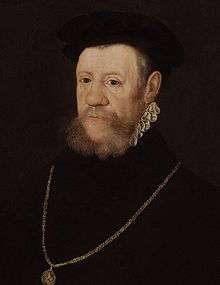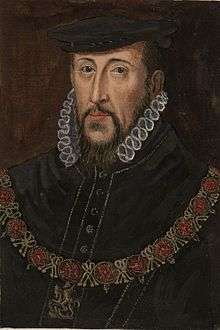Henry Fitzalan, 12th Earl of Arundel
Henry Fitzalan, 12th Earl of Arundel KG (23 April 1512 – 24 February 1580) was an English nobleman, who over his long life assumed a prominent place at the court of all the later Tudor sovereigns, probably the only person to do so.
The Earl of Arundel | |
|---|---|
 Henry Fitzalan, 12th Earl of Arundel, in a portrait from the 1560s. | |
| Lord Lieutenant of Sussex | |
| In office 1559–1551 | |
| Succeeded by | The Lord Lumley |
| Chancellor of the University of Oxford | |
| In office 1558–1559 | |
| Preceded by | Reginald Pole |
| Succeeded by | John Mason |
| Lord Chamberlain | |
| In office 1546–1550 | |
| Preceded by | Lord St John |
| Succeeded by | The Lord Wentworth |
| Personal details | |
| Born | 23 April 1512 |
| Died | 24 February 1580 (aged 67) |
| Spouse(s) | Katherine Grey |
| Children |
|
| Mother | Anne Percy |
| Father | William Fitzalan, 11th Earl of Arundel |

Court career under Henry VIII

He was the only son of William Fitzalan, 11th Earl of Arundel, and his second wife Anne Percy, daughter of Henry Percy, 4th Earl of Northumberland, and was named for Henry VIII, who personally stood as his godfather at his baptism.
At 15, Henry Fitzalan became a page at the court of King Henry VIII, attending the king to Calais in 1532.[1] When he came of age, in 1533, he was summoned to Parliament as Lord Maltravers,[1] a subsidiary title of his father, who was still alive. He attended the trials of Anne Boleyn and her alleged lover Lord Rochford in May 1536.
In 1540 he was appointed deputy of Calais. He remained there, improving the fortifications at his own expense, until his father's death in early 1544. He returned to England to assume the earldom, and was made a Knight of the Garter. War with France soon brought him back to the continent, where he spent much of 1544. He then returned to England, where the king appointed him Lord Chamberlain.[1]
Edward VI
After King Henry's death in 1547, the Earl was Lord High Constable at Edward VI's coronation. He continued as Lord Chamberlain, and in addition, by the terms of Henry's will, was designated one of the council of 12 assistant executors. Under the new King's uncle, Lord Protector Edward Seymour, 1st Duke of Somerset, Arundel's influence diminished, and he soon became an advocate of Somerset's removal.[1]
_by_Hans_Eworth.jpg)
Somerset was deposed and sent to the Tower of London in October 1549, with Arundel, Thomas Wriothesley, 1st Earl of Southampton, and John Dudley, Earl of Warwick (later Duke of Northumberland) among the leaders of the new governing group. In early 1550 Warwick removed Arundel and Southampton, who were religious conservatives, from office. Arundel was placed under house arrest under dubious charges of peculation. He was also fined £12,000, £8,000 of which was later remitted. Within a few months he was cleared of the charges, but the experience pushed him into the camp of the Duke of Somerset, who had been released from the Tower and readmitted to the Privy Council. When Somerset was again arrested in 1551, Arundel was implicated in some of his plots, and was himself arrested and imprisoned for a year. He was eventually pardoned, again heavily fined, and returned to his place on the Council in May 1553.[1]
Intrigues under Mary
King Edward's health was seriously declining, and on 21 June 1553 Arundel was among those who signed Edward's letters patent which conferred the succession on Lady Jane Grey. After the King's death, and after Northumberland had left London, however, together with the Earl of Pembroke, he worked for the proclamation of Mary I on 19 July 1553. Arundel tricked Northumberland into attacking Mary, then called an assembly of the leaders of the city, denounced Northumberland, and had Mary proclaimed queen. Taking the great seal and a letter of submission by the Council, he then rode off to Framlingham, where Mary was staying. He then secured Northumberland in Cambridge, and returned to London with Mary.[1]
At Mary's coronation, Arundel was for the second time High Constable, and was then appointed Lord Steward of the royal household. He served in various roles in her court, being, for example, one of the nobles who received her husband Philip II of Spain when he landed at Southampton. Later, he presided at the trial of the duke of Suffolk, assisted in suppressing Wyatt's rebellion in 1554, was dispatched on foreign missions, and in September 1555 accompanied Philip to Brussels. The same year he and others received a charter under the name of Company of Merchant Adventurers to New Lands, for the discovery of unknown lands, and was made high steward of the University of Oxford, being chosen chancellor in 1559, but resigning his office in the same year. In 1557, on the prospect of the war with France, he was appointed lieutenant-general of the forces for the defence of the country, and in 1558 attended the conference for the negotiation of a peace. He returned to England on the death of Mary in November 1558.[1]
Positions under Elizabeth
Although Elizabeth I did not trust him, he was too powerful to be slighted or ignored, and so he was retained in his various offices when she ascended the throne. For the third time, he had a high place at a royal coronation. However, as a Roman Catholic, he opposed the arrest of his co-religionists and the war with Scotland. He incurred the queen's displeasure in 1562 by holding a meeting at his house during her illness to consider the question of the succession and promote the claims of Lady Catherine Grey. In 1564, being suspected of intrigues against the government, he was dismissed from the lord-stewardship and confined to his house, but was restored to favour in December.[1]
In March 1566 he went to Padua, but being summoned back by the queen he returned to London on the 17th of April 1567. The following year he served on the commission of inquiry into the charges against Mary, Queen of Scots. Subsequently, he furthered the marriage of his daughter Mary with the Duke of Norfolk, together with the restoration of the Roman Catholic religion and government, and deposition of Elizabeth, in collusion with Spain. He made use of an international incident in 1568 as a means of effecting William Cecil's overthrow, and urged upon the Spanish government the stoppage of trade.[1]
In January he alarmed Elizabeth by communicating to her a supposed Spanish project for aiding Mary and replacing her on her throne, and put before the queen in writing his own objections to the adoption of extreme measures against her. In September, on the discovery of Norfolk's plot, he was arrested, but not having committed himself sufficiently to incur the charge of treason in the rebellion he escaped punishment, was released in March 1570, and was recalled by Robert Dudley to the council with the aim of embarrassing Cecil. He again renewed his intrigues, which were at length to some extent exposed by the discovery of the Ridolfi plot in September 1571. He was once more arrested, and not liberated till December 1572 after Norfolk's execution.[1]
He died on the 24th of February 1580, and was buried in the chapel at Arundel Castle, where a monument was erected to his memory.[1]
Coaches were introduced into England from France by Henry Fitzalan, who travelled widely on the Continent in the mid-1560s.[2]
Marriage and children
Henry Fitzalan, 12th Earl of Arundel, was first married to Katherine Grey, daughter of Thomas Grey, 2nd Marquess of Dorset, and Margaret Wotton. By her he had three children:
- Jane FitzAlan (1537–1576/7), who married John Lumley, 1st Baron Lumley
- Henry Fitzalan (1538–1556), styled Lord Maltravers
- Mary FitzAlan (1540–1557), who married Thomas Howard, 4th Duke of Norfolk, and whose son Philip, eventually inherited the Earldom of Arundel.
His second wife was Mary, daughter of Sir John Arundell of a prominent Cornish family, and widow of Robert Radcliffe, 1st Earl of Sussex. They had no children.
Portraiture
Arundel's portrait was painted several times, including once by Hans Holbein and by Hans Eworth.[3]
References
| Wikimedia Commons has media related to Henry FitzAlan, 19th Earl of Arundel. |
- Chisholm 1911, p. 707.
- Matthias Corvinus
- Edward Chaney, The Evolution of the Grand Tour, 2nd ed (London, 2000), p. 8

- Ives, Eric (2009). Lady Jane Grey: A Tudor Mystery. Wiley-Blackwell. ISBN 978-1-4051-9413-6.CS1 maint: ref=harv (link)
- Loades, David (2004). Intrigue and Treason: The Tudor Court, 1547–1558. Pearson/Longman. ISBN 0-582-77226-5.CS1 maint: ref=harv (link)
- "Sir Henry Fitzalan, 19th Earl of Arundel". thepeerage.com. Retrieved 24 February 2008.CS1 maint: ref=harv (link)
External links
| Political offices | ||
|---|---|---|
| Preceded by Unknown |
Lord Lieutenant of Sussex 1559–1561 |
Succeeded by The Lord Lumley |
| Academic offices | ||
| Preceded by Reginald Pole |
Chancellor of the University of Oxford 1558–1559 |
Succeeded by John Mason |
| Political offices | ||
| Preceded by Lord St John |
Lord Chamberlain 1546–1550 |
Succeeded by The Lord Wentworth |
| Peerage of England | ||
| Preceded by William Fitzalan |
Earl of Arundel 1544–1580 |
Succeeded by Philip Howard |
| Baron Maltravers (writ in acceleration) 1533–1580 | ||